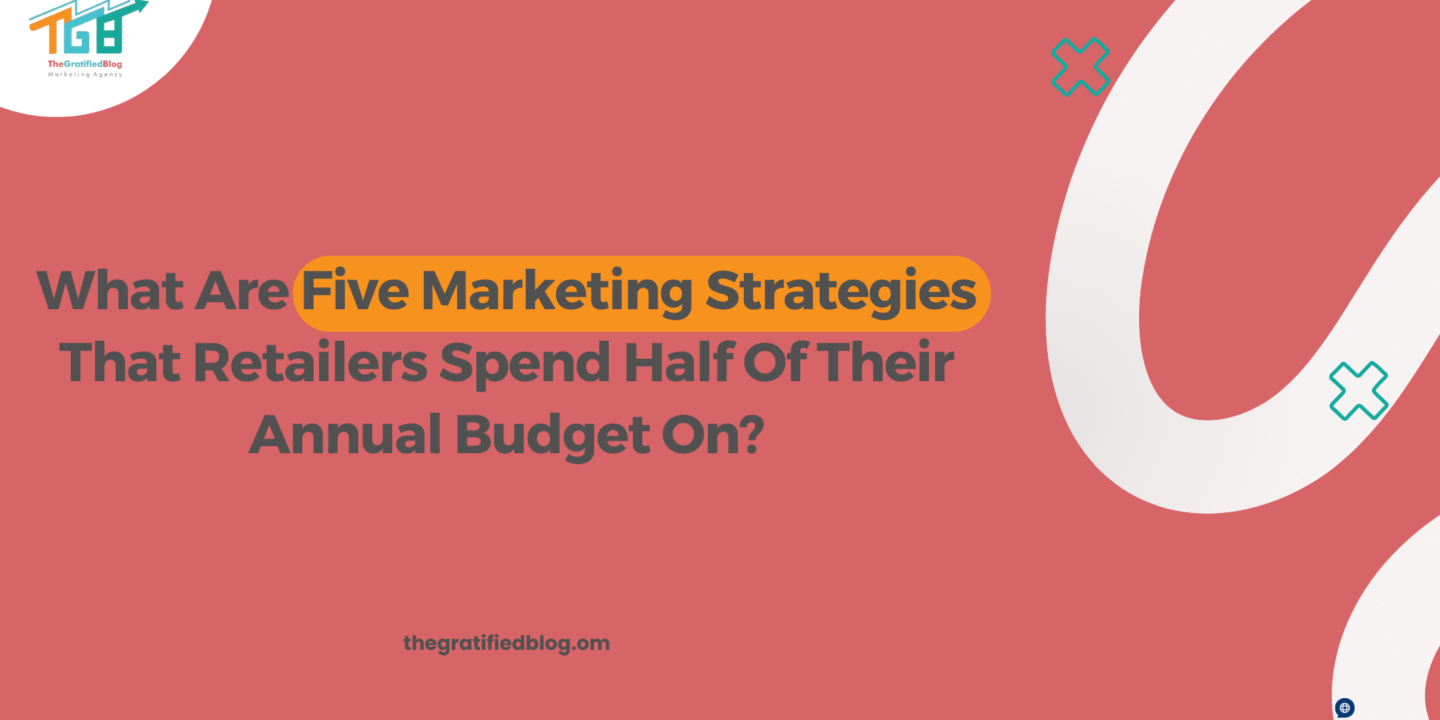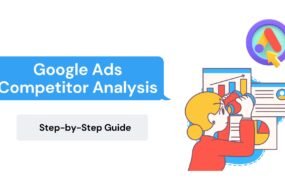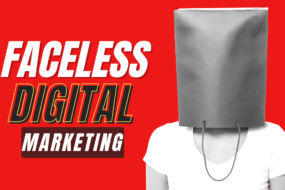
In the dynamic realm of retail, where competition is fierce and consumer preferences constantly evolve, marketing strategies hold the key to success. Large and small retailers recognize the pivotal role of effective marketing in attracting customers, boosting sales, and staying ahead in the game. It’s no secret that retailers allocate a substantial portion of their annual budget to marketing efforts. In this comprehensive exploration, we investigate the question, “What are five marketing strategies that retailers spend half of their annual budget on?” These strategies signify the retailer’s commitment to growth and shed light on the ever-evolving retail marketing landscape. Join us on this journey as we uncover the strategies that shape the retail industry’s present and future.

Let’s begin by delving into the significance of marketing strategies within the retail sector.
The Importance Of Marketing Strategies In The Retail Sector
Marketing strategies are the lifeblood of the retail sector. They are the secret sauce that makes your favorite store or brand stand out in a crowded marketplace.
Here’s why marketing strategies are so crucial in the retail world:
- Attracting Shoppers: In a world overflowing with options, retailers need to catch the eye of potential customers. Marketing strategies help retailers create compelling messages and advertisements that grab people’s attention. Whether it’s a catchy jingle, a social media post, or a stunning storefront display, marketing makes shoppers stop, look, and consider purchasing.
- Building Brand Identity: When you walk into a store and instantly recognize it by its logo or colors, do you know that feeling? That’s the result of effective branding, a key component of marketing. Retailers work hard to create a distinct identity that customers can relate to and trust. Marketing strategies shape this identity and convey what the brand stands for.
- Engaging Customers: Marketing is not just about making a sale; it’s about building relationships. Retailers use various strategies to connect with their customers on a personal level. This could mean sending personalized emails, responding to social media comments, or offering loyalty rewards. These interactions build loyalty and keep customers coming back.
- Driving Sales: Ultimately, marketing strategies are about boosting sales. Whether through discounts, limited-time offers, or special promotions, retailers use marketing to entice shoppers to purchase. Effective strategies can turn browsers into buyers and increase the average transaction value.
- Staying Competitive: Retail is a fiercely competitive industry. Even the best products can get lost in the noise without effective marketing. Marketing strategies help retailers stay competitive by highlighting their unique selling points: quality, price, convenience, or something else.
Now that we’ve grasped the importance of marketing strategies within this sector, let’s unveil the five specific marketing strategies to which retailers allocate a substantial portion of their annual budget.
What Are Five Marketing Strategies That Retailers Spend Half Of Their Annual Budget On?
here are the five marketing strategies on which retailers dedicate a significant share of their annual budget:
- Digital Advertising
- In-Store Visual Merchandising
- Social Media Marketing
- Customer Loyalty Programs
- Data Analytics and Personalization
Now, let’s take a closer look at each of these strategies, delving into the specifics of each one.
Strategy 1: Digital Advertising
- Explanation of the digital advertising landscape in retail
In the digital age, retailers have moved beyond traditional advertising channels like TV and print and embraced digital advertising. This includes ads you see while browsing websites, searching on Google, scrolling through social media, or watching YouTube videos.
It’s like when you search for a new pair of sneakers online, and suddenly, ads for sneakers start popping up on your social media feed.
However, retailers are allocating an increasing portion of their budgets to digital advertising. According to recent studies, on average, retailers allocate around 45-55% of their annual marketing budgets to digital advertising channels. This trend is driven by the growing use of online shopping and the need to reach consumers where they spend a significant amount of their time – on the internet.
- Benefits and challenges of investing in digital advertising
Benefits:
- Precise Targeting: They can target their ads to specific demographics, interests, and behaviors, ensuring they reach the right people at the right time.
- Measurable Results: Digital advertising offers detailed metrics, allowing retailers to track the performance of their campaigns in real time. They can see how many people clicked on an ad, made a purchase, or interacted with their content.
- Cost Efficiency: Digital advertising can be more cost-effective than traditional advertising methods. Retailers can set their budgets and adjust them as needed, making them accessible to businesses of all sizes.
- Global Reach: Retailers can extend their reach to a global audience without the constraints of physical locations. This is especially important for e-commerce businesses.
Challenges:
- Ad Saturation: The digital space is crowded with ads, which can lead to ad fatigue for consumers. Standing out in this environment can be challenging.
- Ad Blocking: Many users employ ad-blockers to avoid digital ads, limiting their effectiveness.
- Data Privacy Concerns: With the increasing emphasis on data privacy, retailers must navigate regulations and consumer concerns regarding collecting and using customer data for targeting.
- Constant Changes: Digital advertising platforms evolve rapidly. To remain effective, retailers must stay updated with changing algorithms, policies, and trends.
- Competition: Competing for attention in the digital world is fierce. Retailers must continually refine their strategies to outperform competitors and capture their audience’s attention.
Strategy 2: In-Store Visual Merchandising

- The role of visual merchandising in retail
Visual merchandising is like arranging products and displays in a physical store to create an appealing and immersive shopping experience. It makes you stop and gaze at a beautifully dressed store window or wander deeper into a store to explore.
Here’s why it’s crucial:
- First Impressions: Visual merchandising is the first thing customers see when they enter a store. It sets the tone for their shopping experience.
- Highlighting Products: It helps retailers showcase their products attractively and enticingly. Think about how a well-organized clothing display makes you want to try those outfits.
- Creating a Story: Effective visual merchandising tells a story about the brand or product. It helps convey a message or a lifestyle associated with what’s on offer.
While the specific budget allocation for in-store visual merchandising can vary widely depending on the retailer’s size and type, it typically accounts for around 5-10% of the total marketing budget. However, this number can be higher for high-end luxury retailers who heavily rely on creating a unique in-store experience to attract customers.
- Examples of effective visual merchandising techniques
- Window Displays: Creating captivating displays in store windows that change with the seasons or promotions can draw people into the store.
- Planogram Layouts: Carefully planning where products are placed on shelves or racks can encourage customers to explore more of the store.
- Color and Lighting: Color and lighting can create a particular atmosphere or highlight specific products.
- Signage and Graphics: Clear and appealing signage can guide customers and convey important information about products or promotions.
Customers often decide whether to walk in based on a store’s appearance. Neon signs are a tremendous in-store decoration.
Store signs and graphics can be customized as neon signs and placed in prominent locations at the entrance or inside the store. Custom neon signs are beautiful and eye-catching, quickly attracting customers’ attention. Any text and pattern can be personalized and customized into neon signs. In addition, there are multiple colours of lights to choose from to make it more colourful.
- How in-store visual merchandising impacts customer experience and sales
- Engagement: An inviting and well-merchandised store keeps customers engaged and encourages them to shop more.
- Impulse Purchases: Visual merchandising can trigger impulse purchases as shoppers are drawn to aesthetically pleasing displays.
- Brand Loyalty: A memorable in-store experience can build brand loyalty, making customers more likely to return in the future and recommend the store to others.
- Increased Sales: Effective visual merchandising can significantly boost sales by influencing customer behavior and choices.
Strategy 3: Social Media Marketing
The significance of social media in modern marketing
Social media marketing is like the virtual word-of-mouth of the digital age. It’s all about using platforms like Facebook, Instagram, Twitter, and more to connect with people, build relationships, and promote products or services.
Here’s why it’s a big deal:
- Massive Reach: Billions of people use social media daily. It’s where your potential customers hang out, making it an enormous marketplace for businesses.
- Engagement: Social media allows brands to interact with customers directly, responding to their questions, comments, and concerns in real time. It’s a two-way conversation.
- Targeting: You can precisely target your ideal customers based on demographics, interests, and behavior. This means your marketing efforts are more likely to reach the right people.
- Content Variety: You can share a wide range of content – from images and videos to blog posts and live streams. This versatility helps keep your audience engaged.
The budget allocation for social media marketing can vary widely depending on the retailer’s size, goals, and industry. However, retailers allocate around 20-30% of their marketing budget to social media marketing. Some retailers, especially those with a solid online presence, may allocate even more.
- The role of influencers and user-generated content in retail marketing
- Influencers: Influencer marketing involves collaborating with individuals with a significant social media following. These influencers can promote your products authentically to their audience. For instance, a beauty influencer might showcase your skincare line in their daily routine. This can create trust and drive sales.
- User-Generated Content (UGC): UGC is like free marketing. It’s when your customers create content related to your products or brand. For example, someone posting a photo wearing your clothing and tagging your brand. Retailers often share UGC on their profiles to build authenticity and showcase happy customers.
- Trust and Authenticity: Influencers and UGC are influential because they’re seen as more authentic than traditional advertising. People trust recommendations from peers or individuals they admire.
- Diversification: Collaborating with various influencers or encouraging UGC allows retailers to diversify their content and reach a broader audience. Different influencers have different followers with unique interests.
Strategy 4: Customer Loyalty Programs
- The importance of customer loyalty in retail
Customer loyalty is like the glue that holds a successful retail business together. It’s all about creating a bond with your customers beyond one-off transactions.
Here’s why it’s a big deal:
- Repeat Business: Loyal customers come back again and again. They’re the ones who choose your store or brand over competitors, leading to consistent sales.
- Word-of-Mouth: Happy, loyal customers become your brand advocates. They recommend your products or services to friends and family, which can drive new customers.
- Cost-Effective: Retaining existing customers is often more cost-effective than acquiring new ones. Loyal customers only require a little marketing spend.
- Feedback Loop: Loyal customers are likelier to provide valuable feedback, helping you improve your products or services.
The budget allocated to loyalty programs can vary widely based on the size and nature of the retail business. Retailers allocate around 5-15% of their marketing budget to loyalty programs. However, some retailers may invest more if their business model relies heavily on building and maintaining a loyal customer base.
- Analysis of different types of loyalty programs (points, tiered, subscription)
- Points-Based: Customers earn points for each purchase, which they can later redeem for discounts or free products. For example, a coffee shop might offer a free coffee after a certain number of purchases.
- Tiered: Customers are grouped into tiers (e.g., silver, gold, platinum) based on loyalty or spending. Each tier offers progressively better rewards. Airlines often use this model with frequent flyer programs.
- Subscription: Customers pay a recurring fee to access exclusive benefits. For example, Amazon Prime offers a monthly fee for free shipping and streaming services.
- Cashback: Customers receive a percentage of their purchase as cash or store credit. This encourages them to keep shopping at the same retailer.
How loyalty programs contribute to long-term profitability
- Increased Customer Retention: Loyalty programs incentivize customers to keep returning, reducing the churn rate and ensuring a stable customer base.
- Higher Average Transaction Value: Loyal customers spend more per transaction, as they are more likely to explore your product range and take advantage of loyalty rewards.
- Word-of-Mouth Marketing: Loyal customers become brand advocates, promoting your business to friends and family, which can lead to new customers without additional marketing expenses.
- Data Collection and Personalization: Loyalty programs allow retailers to gather valuable customer data, enabling personalized marketing efforts that resonate with individual preferences.
- Competitive Advantage: In a crowded market, a robust loyalty program sets you apart from competitors and incentivizes customers to choose your brand.
Strategy 5: Data Analytics And Personalization
The role of data analytics in retail marketing
Data analytics in retail marketing is like having a crystal ball that helps you understand your customers better. It’s all about collecting, analyzing, and interpreting data to make informed decisions.
Here’s why it’s essential:
- Understanding Customers: Data analytics lets retailers see who their customers are, what they buy when they buy, and even why they buy. This information is pure gold for crafting effective marketing strategies.
- Predictive Insights: By crunching numbers, retailers can predict future trends and customer behavior. For example, data might show that certain products sell better during specific seasons.
- Efficiency: It helps retailers allocate their resources more efficiently. Instead of unthinkingly spending on marketing, they can focus on what works best for their target audience.
Budget allocation for data collection and analysis varies widely based on the size and data-driven nature of the retailer. Retailers allocate around 10-20% of their marketing budget to data-related activities. However, some highly data-dependent businesses may allocate more.
- How retailers use data to personalize marketing efforts
- Tailored Recommendations: Retailers analyze past purchases and browsing behavior to recommend products that customers will likely be interested in. Think of Amazon’s “Customers Who Bought This Also Bought…”
- Personalized Emails: Retailers send personalized emails with product recommendations, special offers, or reminders based on a customer’s history. It’s like getting a shopping note from a friend who knows your tastes.
- Customized Content: Websites and apps display content matching customers’ interests. For example, a sports retailer might show football gear to customers who frequently visit the football section.
- Targeted Ads: Data analytics help retailers target their ads to specific demographics and interests. For instance, a pet store might show cat food ads to users who have previously searched for cat-related products.
- The impact of personalization on customer engagement and sales
- Enhanced Customer Experience: Personalization makes customers feel valued. When they see content and recommendations tailored to their preferences, it enhances their shopping experience.
- Higher Conversion Rates: Personalized marketing materials often lead to higher conversion rates. If customers see products they’re genuinely interested in, they’re more likely to purchase.
- Increased Loyalty: When retailers consistently deliver personalized experiences, it builds trust and loyalty. Customers are more likely to return and recommend the brand to others.
- Reduced Cart Abandonment: Personalization can help reduce cart abandonment rates. Retailers can recover potentially lost sales by reminding customers of items they’ve left in their cart or offering discounts on those items.
FAQs
Q: Why Do Retailers Allocate Such A Significant Portion Of Their Annual Budget To Marketing Strategies?
A: Retailers invest heavily in marketing strategies because these tactics are essential for attracting customers, driving sales, and staying competitive in a crowded market. Effective marketing can significantly impact a retailer’s bottom line, making it a worthwhile expenditure.
Q: Are These Five Marketing Strategies Universally Applicable To All Retailers, Regardless Of Their Size Or Industry?
A: While these strategies are widely used in the retail sector, their specific implementation can vary based on a retailer’s size, target audience, and industry. Smaller retailers might focus on a subset of these strategies, while larger ones with more resources may utilize all of them. Adaptation is key to achieving the best results.
Conclusion
Since you now understand the five marketing strategies that retailers use to allocate a significant portion of their annual budget, why not consider employing them to gain a competitive edge?
If you have any questions regarding the blog, then feel free to leave your questions in the comment section. We will be happy to answer your questions.
Thanks for reading 🙂








No Comments